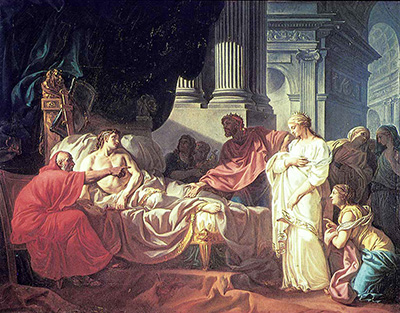Erasistratus was a doctor: and a remarkably good one. Called in by King Seleucus, to find out why his eldest and dearly beloved son should be wasting away despite being, apparently, untouched by disease or blight, Erasistratus used his powers of observation to realise that the young man was in love with his elderly father's new and very young and beautiful wife.
Erasistratus disclosed the malady to the king, pointing out that the young man had behaved honourably, never speaking of his enamourment and deciding to waste away instead of coveting another's wife. The king was so moved by this that he arranged for his wife to marry his son instead, and gifted the young couple with some land too. This anecdote, so proclaimed the Royal Academy, would be the basis for the 1774 Prix de Rome, a highly esteemed contest between all the upcoming artists of the day. The prize was to visit Rome for three to five years, soaking up the art, culture and history of that wonderful city. Having been rejected three times already, Jacques-Louis David set to work, creating a beautiful piece that takes the breath away, even after all this time. On this, his fourth attempt, he succeeded and the painting opened the doors to Rome for him.
In the painting, David makes use of Classic techniques, billowing fabrics, intense chiaroscuro (the play of light and shade) and stylised posing. Erasistratus sits on the left, next to the pining boy, whose headboard gives the impression that the doctor sits on a throne of knowledge, acknowledgement perhaps, of the status of a successful medical man. He is clothed in vibrant red, leaning forward in his chair, with one arm thrust out vigorously, pointing across the width of the painting to where the young wife, Stratonice, is standing. She in turn, is staring modestly at the floor, wrapped up in demure white robes, while the young patient stares at her in dumb adoration from his bed. The king, noticeable from his crown, is central, but shadowed, his hand stretched out imploring to his son, who remains oblivious to his father's distress.
David has accurately depicted the 'ah-hah' moment of realisation and the doctor's intense emotion – almost a fierce joy – at ascertaining the problem can be felt. The painting, in oils on canvas is fairly large at 120cm by 150cm and it can be found hanging in the Ecole Nationale Superieure de Beaux Arts in Paris. The name Erasistratus Discovering the Cause of Antiochus' Disease, is actually short than the original name which added, in David's native French, 'dans son amour pour Stratonice' or 'in his Love for Stratonice'.




